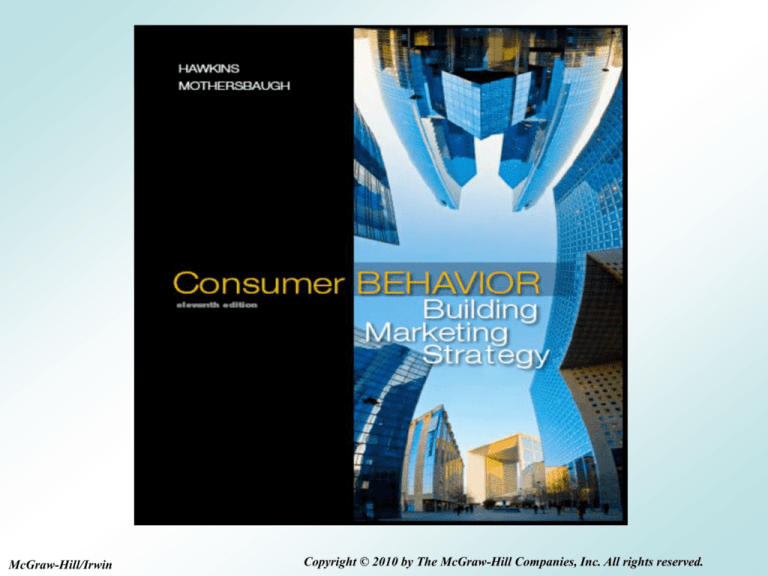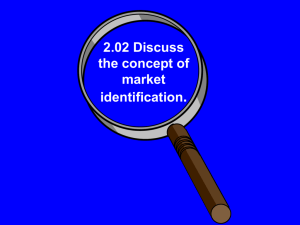
McGraw-Hill/Irwin
Copyright © 2010 by The McGraw-Hill Companies, Inc. All rights reserved.
PART I: INTRODUCTION
1-2
CHAPTER
1
CONSUMER
BEHAVIOR AND
MARKETING
STRATEGY
1-3
Consumer Behavior In The News…
Segmenting the Automobile Market
J.D. Powers Examined Car-Buyer Segments.
Can You Predict the Market for Each Brand?
Honda Civic
Honda Accord
Toyota Sienna Mini Van
Cadillac STS
Lexus LS 430
Source: D. Kiley, “Sexy or Sensible?” Business Week, January 16, 2006, p. 60-61.
1-4
Consumer Behavior In The News…
Segmenting the Automobile Market
J.D. Powers Examined Car-Buyer Segments.
Can You Predict the Market for Each Brand?
Honda Civic – “teenage terror”
Honda Accord – “recent MBA grad”
Toyota Sienna Mini Van – “suburban mom”
Cadillac STS – “mid-career executive”
Lexus LS 430 – “titan of industry”
Source: D. Kiley, “Sexy or Sensible?” Business Week, January 16, 2006, p. 60-61.
1-5
Consumer Behavior and Marketing
Strategy
Consumer behavior is the
study of individuals, groups, or
organizations and the processes
they use to select, secure, use,
and dispose of products,
services, experiences, or ideas
to satisfy needs and the impacts
that these processes have on
the consumer and society.
1-6
Applications of Consumer Behavior
1. Marketing Strategy
2. Regulatory Policy
3. Social Marketing
4. Informed Individuals
1-7
Applications of Consumer Behavior
United Way Campaign
Provides an Example of
Social Marketing
Courtesy United Way of Metropolitan Chicago
1-8
Marketing Strategy and Consumer Behavior
1-9
Market Analysis Components
1. The Consumers
2. The Company
3. The Competitors
4. The Conditions
1-10
Market Segmentation
Market segmentation
is a portion of a larger
market whose needs
differ from the larger
market.
1-11
Market Segmentation
Market Segmentation Involves Four Steps:
1. Identifying Product-Related Need Sets
2. Grouping Customers with Similar Need Sets
3. Describing Each Group
4. Selecting an Attractive Segment(s) to Serve
1-12
Market Segmentation
Market Segment Attractiveness Worksheet
1-13
Marketing Strategy
Marketing Strategy is the answer to the question:
How will we provide superior customer value to our
target market?
This requires the formulation of a consistent
marketing mix, which includes the
1. Product
2. Price
3. Communications
4. Distribution, and
5. Services
1-14
Consumer Decisions
The consumer decision process intervenes between
the marketing strategy, as implemented in the
marketing mix, and the outcomes.
The firm can succeed only if consumers see a need
that its product can solve, become aware of the
product and its capabilities, decide that it is the best
available solution, proceed to buy it, and become
satisfied with the result of the purchase.
1-15
Outcomes
1. Firm Outcomes
2. Individual Outcomes
3. Society Outcomes
1-16
Outcomes
Creating Satisfied Customers
1-17
The Nature of Consumer Behavior
Overall Conceptual Model of Consumer Behavior
1-18
The Nature of Consumer Behavior
External Influences
The following are the major external
influences:
• Culture
• Demographics and social stratification
• Ethnic, religious, and regional subcultures
• Families and households
• Groups
1-19
The Nature of Consumer Behavior
Internal Influences
Internal influences include:
• Perception
• Learning
• Memory
• Motives
• Personality
•Emotions
•Attitudes
1-20
The Nature of Consumer Behavior
Self-Concept and Lifestyle
Self-concept is the totality of
an individual’s thoughts and
feelings about oneself.
Lifestyle is how one lives,
including the products one
buys, how one uses them,
what one thinks about them,
and how one feels about them.
1-21
The Nature of Consumer Behavior
Situations and Consumer Decisions
Consumer decisions
result from perceived
problems and
opportunities.
Consumer problems
arise in specific
situations and the nature
of the situation
influences the resulting
consumer behavior.
Using Outdoor Media to Trigger Problem Recognition
1-22









